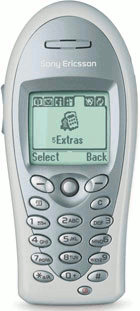GAIT
Due to the dominant worldwide marketshare of GSM and with CDMA having established itself as runner-up, a realization was made that IS-136 TDMA could never achieve the economies of scale necessary to be price competitive. Once carriers decided to migrate away from IS-136 TDMA, their choice of destination was either GSM or CDMA based technology. To facilitate migration on the GSM 3G path, the GSM ANSI 136 Interoperability Team (GAIT) was formed to manage the migration of 2G IS-136 TDMA to 3G GSM/GPRS/EDGE/WCDMA.

Ericsson T-62u GAIT cellphone with AMPS, IS-136 TDMA, GSM, GPRS, Java and a WAP browser, a 2.5G cellular phone.
The first step in this migration was to overlay the existing 2G IS-136 network with 2.5G GSM/GPRS and deploy phones capable of roaming between IS-136 and GSM networks however, in-call handoffs between GSM and AMPS/IS-136 TDMA were not possible nor were calls from AMPS/IS-136 TDMA to GSM. GSM could handoff to GSM and AMPS/IS-136 could handoff to AMPS/IS-136.
Handsets had to support GSM, IS-136 TDMA and AMPS as transparently as possible. Meaning, the user should not be able to determine visually or audibly what network the phone was on be it AMPS-TDMA 800/1900 Mhz, or GSM 800/900/1900 Mhz.
Network Selection
GAIT phones had to be able to select between IS-136 TDMA or GSM networks. To facilitate this process, four basic modes were created; GSM Native, ANSI-136 Native, GSM Foreign and ANSI-136 Foreign.
GSM Native
The mobile is homed to a GSM network, is operating on a GSM network and is able to perform standard GSM type functions including SMS and Data services.
IS-136 TDMA Native
The mobile is homed to an IS-136 TDMA network and is operating on an IS-136 TDMA network. In this mode, the mobile is able to perform standard IS-136 TDMA functions including text messaging using GHOST SMS.
GSM Foreign
The mobile is homed to an IS-136 TDMA network but is operating on a GSM network. At this time, the GSM portion of the phone is operational and the network's Interworking and Interoperability Function (IIF) handles the call delivery and SMS routing from the ANSI-136 network to the serving GSM network.
IS-136 TDMA Foreign
This is where a GSM native subscriber is accessing an ANSI-136 network. Again, routing of calls and SMS is handled by the network's Interworking and Interoperability Function.
Teleservices
GSM Hosted SMS Teleservice (GHOST) enabled GAIT mobiles to use GSM SMS for messaging and over-the-air programming in both GSM and TDMA modes. In TDMA mode, the GSM SMS PDU (Protocol Data Unit) was tunneled across the IS-136 TDMA air interface. When in GSM or IS-136 TDMA, the SMS message was based on the GSM 03.40 protocol.




